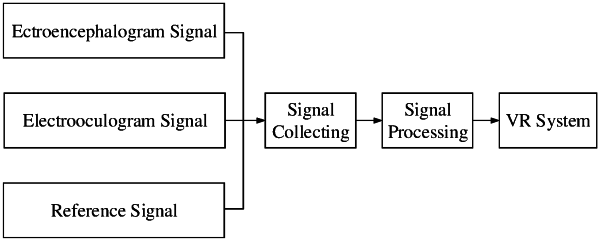| CPC A61B 5/0004 (2013.01) [A61B 5/369 (2021.01); A61B 5/6803 (2013.01); G06F 1/163 (2013.01)] | 18 Claims |

|
1. A wearable device, wherein the wearable device is an augmented reality (AR) device or a virtual reality (VR) device comprising a processor, a signal collector electrically connected to the processor, and a stimulation generator configured to provide a stimulation signal;
wherein the stimulation generator comprises a display panel capable of displaying at different regions with different flicker frequencies to trigger a generation of different electroencephalogram signals;
wherein the signal collector comprises exactly four electroencephalogram sensors configured to collect electroencephalogram signals and at least one electrooculogram sensor configured to collect electrooculogram signals, the four electroencephalogram sensors consisting of an O1 sensor, an O2 sensor, an Oz sensor, and a Pz sensor;
wherein the processor is configured to:
fit, through canonical correlation analysis (CCA), first electroencephalogram signals to a template signal for electroencephalogram signals, wherein the first electroencephalogram signals are collected by the signal collector while a preset operation corresponding to electroencephalogram signals is being executed, the preset operation corresponding to electroencephalogram signals comprises observing at least two regions with different flicker frequencies on the display panel by a user, such that I stimulation signals are provided, with the template signal for electroencephalogram signals being denoted as a first variable group Y defined as:
 where fi represents a stimulation frequency of the i-th stimulation signal, fs represents a stimulation frequency of a standard stimulation signal, and t represents a sequence number ranging from 1 to L, I and i both being positive integers, and I being greater than or equal to i;
fit, through the CCA, first electrooculogram signals to a template signal for electrooculogram signals, wherein the first electrooculogram signals are collected by the signal collector while a preset operation corresponding to electrooculogram signals is being executed, and the template signal for electroencephalogram signals and the template signal for electrooculogram signals each consists of a sine wave signal and a cosine wave signal;
extract, from the first variable group by using Fourier transform, an electroencephalogram eigenvector for an electroencephalogram signal classification;
extract, from the template signal for electrooculogram signals by using Fourier transform, an electrooculogram eigenvector for an electrooculogram signal classification;
cause the four electroencephalogram sensors to collect four channels of electroencephalogram signals in real time, the four electroencephalogram channels of signals being denoted as a second variable group X defined as:
 generate a first control signal based on a first classification result obtained by using the second variable group and the electroencephalogram eigenvector, the first control signal indicating a target region in the at least two regions; and
generate a second control signal based on a second electrooculogram signal collected by the signal collector in real time, and the electrooculogram eigenvector;
wherein the processor is further configured to cause the wearable device to:
perform a moving operation for a character in an application according to the second control signal; and
perform a control operation for the target region in the application according to the first control signal.
|